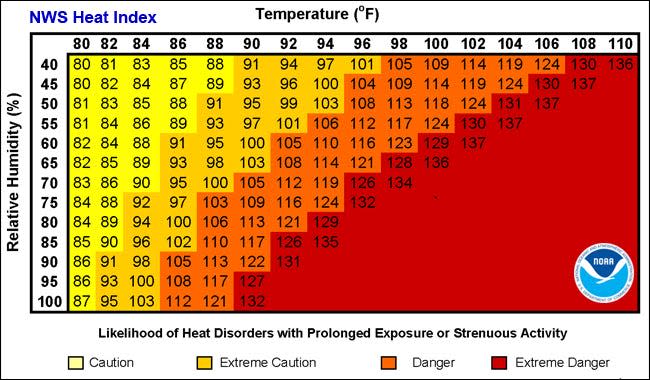The weather in Delaware is about to take a massive turn from early spring to the middle of summer in just a matter of days.
According to the National Weather Service, Wilmington could set the record for the lowest high temperature for June 15. The record is 67 degrees, which was set in 1933 and 1950.
The high temperature on June 15, 2025, was forecasted to be 68 degrees, putting Wilmington in a position to set or tie the record.
When will Delaware warm up?
First State residents will only have a couple more days of gloom before being thrust into some mid-summer temperatures
The National Weather Service is calling for high temperatures to hit Delaware starting on June 18. The high for Wilmington is forecasted to hit 86 degrees. Dover is expected to hit 88 degrees and Georgetown is expected to hit 88 degrees on June 18.
Delaware will move into the Juneteenth weekend, hitting the 90s on June 19. In Wilmington, the high is forecasted to hit 90. Dover and Georgetown are expected to hit 91.
Temperatures will dip into the mid-80s on Friday, with the highs in Wilmington and Dover expected to hit 85.
As for the remainder of the weekend, the National Weather Service is calling for a 50% to 60% chance of temperatures being above normal.
Prepare for this summer: What to know when extreme hot weather is forecasted
What is heat index?

Heat index calculator
We’ve all heard: “It’s not the heat; it’s the humidity.” Well, it’s not just a cliché; there is truth to it. According to the National Weather Service, the heat index is what the temperature feels like to the human body when relative humidity is combined with the air temperature.
Put it simply, when the body sweats, the perspiration evaporates, cooling the body. When the humidity is high, the sweat doesn’t evaporate as quickly and the body doesn’t cool itself as well. Therefore, the body feels warmer. The heat index represents the heat you’re feeling outside.
There are four classifications for heat index, according to the National Weather Service:
Caution: When the heat index is 80-90 degrees, the body may feel fatigued with prolonged exposure and physical activity.
Extreme caution: When the heat index is 90-103 degrees, the body may feel heat stroke, heat cramps and heat exhaustion with prolonged exposure and physical activity.
Danger: When the heat index is 103-124 degrees, heat cramps or heat exhaustion are likely and heat stroke is possible with prolonged exposure and physical activity.
Extreme danger: When the heat index is 125 degrees or higher, heat stroke is likely.
Heat Index calculator
Here’s a chart to help you find out what the heat index is. You can also use this heat index calculator.
What are heat-related illnesses?

Heat exhaustion vs heat stroke. Here are the differences and what you should do.
With the warm weather in the forecast, it’s good to prepare for possible issues.
During extremely hot and humid weather, the body is challenged to cool itself. When the body struggles too much, several heat-related illnesses can occur. According to the National Weather Service, here’s what to watch for:
Heat cramps: Heat cramps are the first sign of heat-related illnesses. The symptoms include muscle cramps and spasms, typically in the legs or abdomen. You should apply pressure on the cramping muscle or gently massage the muscle. The person should also try to sip water unless they are nauseous. If the cramps last more than an hour, the person should seek medical attention.
Heat exhaustion: A person who has heat exhaustion will sweat heavily, be tired, cool and clammy, have a weak, fast pulse, have muscle cramps, dizziness, nausea, headaches and may faint. Move the person to a cool area, loosen clothes, and apply cool, wet clothes or have the person sit in a bath. Offer water. If a person vomits more than once or symptoms worsen, seek immediate medical attention.
Heat stroke: The symptoms of heat stroke include a body temperature above 103 degrees, a throbbing headache, confusion, nausea, fainting or a loss of consciousness. Call 911 or get the person to a hospital immediately.
How to handle pets in the heat

Summer heat
When heat waves hit, dogs are also susceptible to heat stress and heat strokes, according to the American Kennel Club.
Heat stress: Heat stress in dogs occurs when a dog’s resting temperature hits 104 degrees. The signs and symptoms of heat stress include a dog looking for shade, limiting its movements, choosing to sit or lie down, panting, vomiting and excessive salivation.
Heat stroke: This condition occurs when your dog’s resting body temperature exceeds 106 degrees. The symptoms include the dog acting confused; excessive drooling and thickening saliva; gums being bright red, blue or purple; refusing to drink water; losing consciousness; or having seizures. Immediate veterinary attention is required.
If your pet is exposed to extreme heat, the AKC suggests getting your dog to a shady spot, applying ice packs under the dog’s front legs on their chest, and pouring cold water over their head and body. Dogs should be given water to drink. A cooling mat for the dog to sit or stand on would be helpful as well.
In addition, according to the American Kennel Club, with temperatures 85 degrees or higher for a sustained period, dog owners need to be careful with hot asphalt, pavement and sand. The hot surface can cause blisters on your pet’s paws.
This article originally appeared on Delaware News Journal: Wilmington could set a temperature record. When will Delaware heat up
